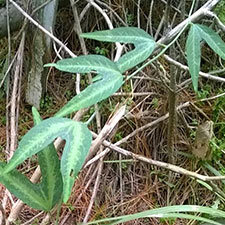 Bat-wing passionflower
Bat-wing passionflower
Common name: Bat-wing passionflower
Botanical name: Passiflora apetela
Management programme: Exclusion
Where is it originally from?
Bat-wing passionflower is native to Costa Rica, Panama, Honduras and Mexico. A relatively new introduction to New Zealand in the 1990s, it gets its name from its bat-wing shaped leaves and flowers that are very similar to the passionfruit flower.
Why is it a pest?
- Bat-wing passionflower climbs up into and across the tops of trees and plants. The dense leaves shade out and eventually smothers its host plant.
- It’s a prolific seeder. A mature vine (2-3 years) can produce up to 3,000 fruit with an average of 15 seeds per fruit!
- There is no off-season for this plant. It produces seeds year-round which birds feed on. This is a very invasive quality which allows the plant to spread at a rapid rate.
- Can also grow from stems that touch the ground and from broken off fragments.
Where is it found?
There are no known sites of bat-wing passionflower in the Bay of Plenty and we want to keep it that way.
Bat-wing passionflower can grow in a range of locations as it is shade tolerant. High risk locations can include regenerating native forest and scrub, home gardens, hedges and fence lines. Basically, wherever birds rest and poo the seeds out.
What does it look like?
- Distinguishing feature is the bat-winged shaped leaves.
- Adult leaves often have a sheen, while younger plants are more matte.
- Small (7-12mm diameter) yellow or light green coloured flowers (all year round).
- Small (7-15mm diameter) black berries about the size of a small grape (all year round, following flowering).
What are the rules?
Exclusion
Exclusion pests are not known to be present in the Bay of Plenty region. The Bay of Plenty Regional Council is responsible for managing any new incursions into the region. Landowners or occupiers may be required to support a control operation to be undertaken.
How do you get rid of it?
Please contact the Bay of Plenty Regional Council if you think you have found bat-wing passionflower.
Images




